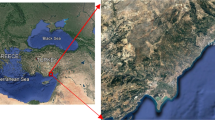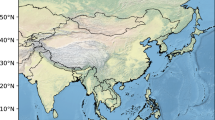Abstract
It is believed that the Tibetan Plateau plays an important role in shaping the global atmospheric circulation and climate change. Due to the lack of observations in its surrounding area, previous studies mostly relied on numerical and empirical models to characterize the atmosphere over the Tibetan Plateau. For example, NRLMSISE-00 is a neutral atmospheric empirical model that has been widely used. In this study, NRLMSISE-00 model temperature data were compared with radiosonde temperature profiles obtained over Golmud, which is located in the northeast part of the Tibetan Plateau. Certain degree of deviations has been observed, especially in the warm season (here we defined from May 16 to October 15), with the temperature difference up to 19 K. A three-layer feed-forward neural network (NN) has been built to improve the NRLMSISE-00 model. Radiosonde temperature profiles from year 2013 to 2014 were used as training database for this NN. The radiosonde temperatures in year 2015 were then used to evaluate this method. Our results showed that the deviations between the NRLMSISE-00 model and the in situ radiosonde data have been significantly reduced. This study demonstrates the feasibility of NN for improving the atmospheric model accuracy using radiosonde data as training samples.







Similar content being viewed by others
References
Bai Z, Bian J, Chen H (2017) Variation in the tropopause transition layer over China through analyzing high vertical resolution radiosonde data. Atmos Ocean Sci Lett 10:114–121. https://doi.org/10.1080/16742834.2017.1256188
Barnett J, Corney M (1985) Middle atmosphere reference model derived from satellite data. In: Labitzke K, Barnett JJ, Edwards B (eds) Handbook MAP. University of Illinois, Urbana, pp 47–85
Bates DR (1959) Some problems concerning the terrestrial atmosphere above the 100 km level. Proc R Soc A Math Phys Eng Sci 253:451–462. https://doi.org/10.1098/rspa.1959.0207
Bell SW, Geller MA (2008) Tropopause inversion layer: seasonal and latitudinal variations and representation in standard radiosonde data and global models. J Geophy Res Atmos 113:D05109. https://doi.org/10.1029/2007JD009022
Bian J (2009) Recent advances in the study of atmospheric vertical structures in upper troposphere and lower stratosphere. Adv Earth Sci 24(3):262–271. https://doi.org/10.3321/j.issn:1001-8166.2009.03.005
Bian J, Chen H, Lu D (2004) Analysis of statistical characteristics of gravity waves in the upper stratosphere over Beijing using vertical high-resolution sounding data. Sci China Ser D Earth Sci 48:1548–1548
Bruinsma SL, Sánchez-Ortiz N, Olmedo E, Guijiarro N (2012) Evaluation of the DTM-2009 thermosphere model for benchmarking purposes. J Space Weather Space Clim 2(A04):1–14. https://doi.org/10.1051/swsc/2012005
Che Y, Ma S, Xing F, Li S, Dai Y (2019) An improvement of the retrieval of temperature and relative humidity profiles from a combination of active and passive remote sensing. Meteorol Atmos Phys 131:681–695. https://doi.org/10.1007/s00703-018-0588-3
Chen X, Hu X, Xiao C, Wang X (2013) Correction method of the low earth orbital neutral density prediction based on the satellites data and NRLMSISE-00 model. Chin J Geophys 56:3246–3254. https://doi.org/10.6038/cjg20131003
Chernykh IV, Eskridge RE (1996) Determination of cloud amount and level from radiosonde soundings. J Appl Meteorol 35:1362–1369. https://doi.org/10.1175/1520-0450(1996)035%3c1362:DOCAAL%3e2.0.CO;2
Doornbos E, Klinkrad H, Visser P (2008) Use of two-line element data for thermosphere neural density model calibration. Adv Space Res 41:1115–1122. https://doi.org/10.1016/j.asr.2006.12.025
Fueglistaler S, Desller AE, Dunkerton TJ, Folkins I, Fu Q, Mote PW (2009) Trpical tropopause layer. Rev Geophys 47:1–31. https://doi.org/10.1029/2008RG000267
Gao D (1998) On structures of supervised linear basis function feedforward three-layered neural networks. Chin J Comput 21:80–86 (in Chinese)
Haykin S (1999) Neural networks: a comprehensive foundation, 2nd edn. Macmillan College Publishing, New York
Hedin AE (1983) A revised thermospheric model based on mass spectrometer and incoherent scatter data: MSIS-83. J Geophys Res 88(A12):10170. https://doi.org/10.1029/ja088ia12p10170
Hedin AE (1987) MSIS-86 thermospheric model. J Geophys Res 92:4649–4662
Hedin AE (1991) Extension of the MSIS thermosphere model into the middle and lower atmosphere. J Geophys Res Space Phys 96:1159–1172. https://doi.org/10.1029/90JA02125
Hedin AE, Reber CA, Newton GP et al (1977) A global thermospheric model based on mass spectrometer and incoherent scatter data MSIS, 2. Composition. J Geophys Res 82(16):2148–2156. https://doi.org/10.1029/JA082i016p02148
Hoinka KP (1998) Statistics of the global tropopause pressure. Mon Weather Rev 126(12):3303–3325. https://doi.org/10.1175/1520-0493(1998)126%3c3303:sotgtp%3e2.0.co;2
Hsieh WW, Tang B (1998) Applying neural network models to prediction and data analysis in meteorology and oceanography. Bull Am Meteorol Soc 79:1855–1870. https://doi.org/10.1175/1520-0477(1998)079%3c1855:ANNMTP%3e2.0.CO;2
Kulkarni S, Harman G (2011) Multilayer networks. In: Kulkarni S, Harman G (eds) An elementary introduction to statistical learning theory. Wiley, New York, pp 99–115. https://doi.org/10.1002/9781118023471.ch10
Labitzke K, Barnett JJ, Edwards B (eds) (1985) Middle atmosphere program, MAP handbook, vol 16. University of Illinois, Urbana
Mao K, Zuo Z, Shen X, Xu T, Gao C, Liu G (2018) Retrieval of land surface temperature from AMSR2 data using a deep dynamic learning neural network. Chin Geogr Sci 28:1–11. https://doi.org/10.1007/s11769-018-0930-1
Martin JD, Morton YT, Zhou Q (2005) Neural network development for the forecasting of upper atmosphere parameter distributions. Adv Space Res 36:2480–2485. https://doi.org/10.1016/j.asr.2003.12.015
Miao J, Liu S, Li Z, Qin G, Tang G (2011) Atmospheric density calibration using the real-time satellite observation. Chin J Space Sci 31:459–466 (in Chinese)
Picone JM, Hedin AE, Drob DP et al (2000) Enhanced empirical models of the thermosphere. Phys Chem Earth Part C 25(5):537–542. https://doi.org/10.1016/S1464-1917(00)00072-6
Picone JM, Hedin AE, Drob DP (2002) NRLMSISE-00 empirical model of the atmosphere: statistical comparisons and scientific issues. J Geophys Res 107:SIA 15-1–SIA 15-16. https://doi.org/10.1029/2002JA009430
Santer BD (2003) Contributions of anthropogenic and natural forcing to recent tropopause height changes. Science 301(5632):479–483. https://doi.org/10.1126/science.1084123
Sausen R, Santer BD (2003) Use of changes in tropopause height to detect human influences on climate. Meteorol Z 12(3):131–136. https://doi.org/10.1127/0941-2948/2003/0012-0131
Shi L (2001) Retrieval of atmospheric temperature profiles from AMSU-A measurement using a neural network approach. J Atmos Ocean Tech 18(340):347. https://doi.org/10.1175/1520-0426(2001)018%3c0340:ROATPF%3e2.0.CO;2
World Meteorological Organization (WMO) (2003) WMO scientific assessment of ozone depletion 2002. WMO global ozone research and monitoring project report 47, Geneva, Switzerland, 2003, p 798
World Meteorological Organization (WMO) (1957) Meteorology—a three-dimensional science: second session of the commission for aerology. WMO Bull 6:134–138
World Meteorological Organization (WMO) (1986) Atmospheric ozone 1985: global ozone research and monitoring project report 20, Geneva, Switzerland, p 392
Xiao C, Hu X (2010) Applying artificial neural networks to modeling the middle atmosphere. Adv Atmos Sci 27:883–890. https://doi.org/10.1007/s00376-009-9019-1
Zhou X, Zhao P, Chen J, Chen L, Li W (2009) Impacts of thermodynamic processes over the Tibetan Plateau on the northern hemispheric climate. Sci China Ser D Earth Sci 52:1679–1693. https://doi.org/10.1007/s11430-009-0194-9
Acknowledgements
This work was supported by the National Natural Science Foundation of China (NSFC) (Grant no. 41127901). The authors would like to acknowledge the Golmud Meteorological Bureau for providing radiosonde data.
Author information
Authors and Affiliations
Corresponding author
Additional information
Responsible Editor: S. Trini Castelli.
Publisher's Note
Springer Nature remains neutral with regard to jurisdictional claims in published maps and institutional affiliations.
Rights and permissions
About this article
Cite this article
Dai, Y., Pan, W., Hu, X. et al. An approach for improving the NRLMSISE-00 model using a radiosonde at Golmud of the Tibetan Plateau. Meteorol Atmos Phys 132, 451–459 (2020). https://doi.org/10.1007/s00703-019-00700-w
Received:
Accepted:
Published:
Issue Date:
DOI: https://doi.org/10.1007/s00703-019-00700-w




